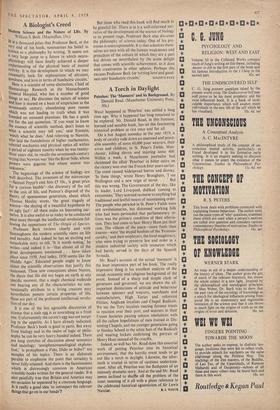A Torch in Daylight
WHAT happened at Peterloo' was settled a long time ago. Why it happened has long remained to be explored. Mr. Donald Read, in this humane, learned and sensible book, has set this fascinating historical problem at rest once and for all. On a hot August noonday in the year 1819, a body of cavalry rode down an unarmed and peace- able assembly of some 60,000 poor weavers, their wives and children, in St. Peter's Fields, Man- chester, killing eleven and injuring some 400. Within a week, a Manchester journalist had christened the affair Peterloo' in bitter satire on the victory won over the French four years earlier. The event caused widespread horror and dismay. `In these things,' wrote Henry Brougham, 'I see Wellington and a new reign of terror. . . .' But this was wrong. The Government of the day, like its leader, Lord Liverpool, disliked 'coming to extremities.' They scorned recourse to anything but traditional and lawful means of maintaining order. The people who paraded in St. Peter's Fields were not revolutionaries, but distressed working folk who had been, persuaded that parliamentary re- form was- the primary condition of their allevia- tion. They had come to hear Henry Hunt put their case. The villains of the piece—more fools than knaves—were 'the stupid boobies of the Yeoman- cavalry,' and their employers, the local magistracy, who were trying to preserve law and order in a modern industrial society with resources which had barely served in the days of the Spanish Armada.
Mr. Read's account of the actual 'massacre' is the least impressive part of his book. The really impressive thing is his excellent analysis of the social, economic and religious background of the event. Instead of a sharp and simple clash of governors and 'governed, we are shown the all- important distinctions of attitude and behaviour between spinners and weavers, merchants and manufacturers, High Tories and reformist Pittites, Anglican loyalists and Chapel Radicals. We see the Tory loyalists roaring fatuous toasts to reaction over their port, and weavers in their Union Societies passing solemn resolutions with all the callow hopefulness of men trained in Dis- senting Chapels, and the younger generation going to Sunday School in the white hats of the Radical's and wearing lockets enshrining the portrait of Henry Hunt instead of the crucifix.
Indeed, so well has Mr. Read done this essential work of putting Peterloo into its historical environment, that the horrific event tends to go out like a torch in daylight. Likewise, the after- math is treated in terms of cautious understate- ment. After all, Peterloo was the flashpoint of an intensely dramatic story. And at the end Mr. Read seems inclined to shuffle off the problem of the inner meaning of it all with a pious reference to the celebrated historical agnosticism of Sir Lewis






























 Previous page
Previous page